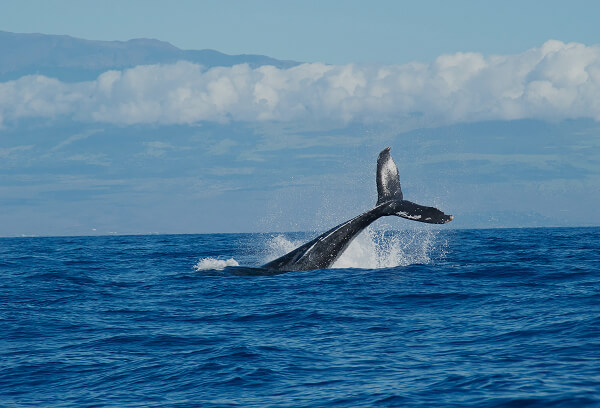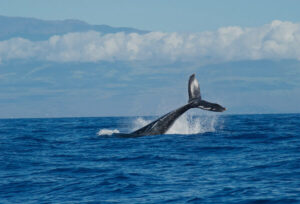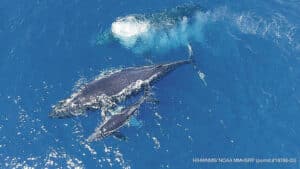 When people think of whale watching in Hawaiʻi, humpback whales usually steal the spotlight — and for good reason. Each winter, thousands migrate to the islands, making them the most visible and celebrated species in Hawaiian waters.
When people think of whale watching in Hawaiʻi, humpback whales usually steal the spotlight — and for good reason. Each winter, thousands migrate to the islands, making them the most visible and celebrated species in Hawaiian waters.
But humpbacks aren’t the only whales you can see here. Odontocetes — or toothed whales — are also frequent visitors to the warm Pacific surrounding Maui, Molokaʻi, Lānaʻi, and Kahoʻolawe. Unlike the migratory humpbacks, many of these whales can be spotted year-round, giving locals and visitors alike a chance to encounter an incredible diversity of marine life. The four most common include:
- false killer whales
- melon-headed whales
- pygmy killer whales
- short-finned pilot whales
What Are Odontocetes?
Odontocetes are toothed whales, a group that includes dolphins, porpoises, and several fascinating whale species. They differ from humpbacks and other baleen whales in that they use teeth and echolocation to hunt fish and squid.
Around Hawaiʻi, the odontocetes you’re most likely to encounter include:
-
Short-finned pilot whales
-
False killer whales
-
Melon-headed whales
-
Pygmy killer whales
-
Plus occasional sightings of orcas (killer whales)
These species are often spotted in large pods, sometimes numbering in the hundreds. Watching them swim, dive, and interact socially is a completely different experience from spotting solitary humpbacks and there are plenty of whale watching tours that promise sightings.
Odontocete Sightings in Hawaiʻi
Researchers with the Pacific Whale Foundation’s Wild Whale and Dolphin Project recorded more than 62 odontocete sightings in just a three-month period around Maui County. These included:
-
Spinner, spotted, bottlenose, and rough-toothed dolphins
-
Short-finned pilot whales
-
Melon-headed whales
-
Orcas
Some of the groups were massive — one pod of melon-headed whales numbered over 400 individuals.
The sightings highlight how Maui, Lānaʻi, and Molokaʻi form a prime habitat for these species, thanks to the deep offshore waters surrounding the islands.
Pilot Whales: Hawaiʻi’s Year-Round Residents
The most frequently seen odontocete whales off Maui are short-finned pilot whales.
-
Size: 12–16 feet long, 1.5–2.5 tons
-
Appearance: Bulbous head, curved dorsal fin, dark gray to black coloring
-
Social Behavior: Found in pods averaging 20–30 animals
Pilot whales are highly social and often travel in tight family groups. Seeing a pod move together across the surface of the ocean is one of the most memorable whale watching experiences in Hawaiʻi.
False Killer Whales: Rare but Striking
False killer whales are rarer but especially exciting for whale watchers.
-
Size: 13–16 feet long, up to 2,500 pounds
-
Appearance: Sleek black body with a lighter gray belly
-
Behavior: Known for leaping and sometimes bow-riding with boats
Despite their name, they look very little like true killer whales. They are intelligent, fast-moving, and occasionally interact with human vessels, making them a favorite among researchers and photographers.
Melon-headed Whales: The Pod Builders
Melon-headed whales are smaller odontocetes that often gather in enormous pods.
-
Size: 7–8 feet long, ~350 pounds
-
Appearance: Black backs with a lighter gray throat patch
-
Behavior: Extremely social; pods can include hundreds of individuals
One recorded sighting near Maui included 400 melon-headed whales swimming together — a rare and unforgettable event.
Orcas in Hawaiʻi: Occasional Visitors
While they aren’t common, orca whales (killer whales) have been sighted off the coast of Lānaʻi and other islands. Researchers believe these belong to a population of “rogue killer whales” that travel in small groups and sometimes feed on unexpected prey.
-
Males: Up to 28 feet long, ~8 tons
-
Females: About 23 feet long, ~4 tons
-
Behavior: Opportunistic hunters, sometimes seen attacking other whales or large fish
Spotting orcas in Hawaiʻi is extremely rare, but for whale watchers lucky enough to witness them, it’s a once-in-a-lifetime event.
Whale Watching Tips for Visitors
If you’re visiting Hawaiʻi and want to maximize your chances of seeing odontocete whales:
-
Take a Maui whale watching tour — boats often explore deep channels between Maui, Molokaʻi, and Lānaʻi where odontocetes thrive.
-
Look for pods — unlike humpbacks, these whales are usually in groups. Watch for splashes across a wide area of ocean.
-
Bring binoculars and a camera — odontocetes can surface briefly and then dive deep, so having gear ready is essential.
-
Be patient — sightings aren’t guaranteed, but with so many species in Hawaiian waters, chances are good.
FAQs About Odontocete Whales in Hawaiʻi
Are orcas found in Hawaiʻi?
Yes — though rare, orca whales have been sighted, mostly around Maui and Lānaʻi.
What is the most common toothed whale in Hawaiʻi?
Short-finned pilot whales are the most frequently seen odontocetes around Maui.
Can you see dolphins while whale watching in Hawaiʻi?
Absolutely. Spinner, spotted, bottlenose, and rough-toothed dolphins are often spotted alongside odontocete whales.
When is the best time to see odontocetes in Hawaiʻi?
Many species are present year-round, unlike humpbacks which are seasonal.







